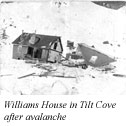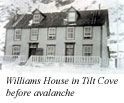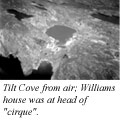Date: March 11, 1912
Location: Tilt Cove, Baie Verte Peninsula
Easting: 598250
Northing: 5526700
Latitude: 49° 53′ 00″ N
Longitude: 55° 38′ 00″ W
Fatalities: 5
Injuries: 5
Source: “Where Was That” by Mosdell, Newfoundland Herald, Jan 25th- Feb 15, 1986 (photos from Provincial Archives and the family of the late Dr. Smith), Daily News
The copper deposit that led to the establishment of the Tilt Cove mine was discovered in 1857, and by 1864 a mining community was established in Tilt Cove. By 1869 nearly 800 people were dwelling in the confined spaces of the rocky cove. The Cape Copper Company took over operations in the 1880s, and when Francis Williams moved there to manage the mine in the last decade of the century, Tilt Cove hosted over 1000 people including a doctor, telegraph operator, policeman, tailor, blacksmith and teacher.
When Francis Williams moved to Tilt Cove to manage the mining operations there it seems he did not consider the potential dangers despite the recent avalanches in Betts Cove, a few miles along the coast. He decided to build his house, a rather distinguished two storey building, at the head of the cove, far removed from the mine itself, and the cottages of the miners – despite warnings from locals. Joining him in building in this somewhat exclusive location were William Cunningham, telegraph operator, postmaster, customs agent and Justice of the Peace, and Dr. Smith.
William Cunningham’s daughter, Vera, was interviewed in 1996 – she was 95 at the time but vividly remembered life in Tilt Cove, and in particular the afternoon of March 11 1912 (Churchill Harbinger, 1996). She recalls that the previous night, following a day of freezing rain a snow storm raged and this continued through the day. Her father came in for tea and said, prophetically, “this would be a great night for snow-sliding“. Next door the Williams family was sitting down to tea, when a large avalanche swept down the slope and struck the Williams and Cunningham houses. The avalanche just glanced Doctor Smith’s house, which escaped with minor damage. The Williams house was most severely damaged, with the lower floor collapsing as the rear wall was staved in. The Cunningham house was swept off its foundation and Emily Day the family servant thrown across the kitchen and buried. She had three year-old Edward Cunningham in her arms and protected him against the weight of the snow. Unfortunately she was buried jammed against the kitchen stove, and by the time she was dug out two hours later was very severely burnt. Edward was only slightly burnt, and recovered well. Emily survived but was badly hurt; she was sent to hospital in St. John’s but died in July. The rest of the family survived almost unscathed- Vera had her foot pinned under a beam and could still feel pain and swelling in it 80 years later – her “snow-slide” foot she called it.
The occupants of the Williams house were deeply buried and it was not until after 3 hours of digging that the rescuers heard voices. A rescuer asked “Who is speaking?” and the answer came “Mrs. Williams is speaking. We are here, alive, two girls and myself, but God knows where the others are, but we were all at tea in this room together, and the two servants in the kitchen“. It took another half-hour of careful digging to extricate the three, and despite their ordeal all recovered. Mrs. Williams was cut on the face and chest and had two nails driven in her foot; the two girls were both badly bruised. The rescuers continued digging, despite continued dreadful weather, and eventually came upon the bodies of Francis Williams, and lying beside him, his 13-year-old son, James. They had apparently been killed instantly – according to the Evening Telegram report, “the little boy was found dead with bread still in his mouth“. Rescue efforts continued unabated, but it was not until 9 o’clock the next morning that the final two occupants of the Williams house were discovered, a brother and sister with the surname Sage (Francis and Peter?). Both had apparently been killed instantly.
The funerals took place on March 14th, with the Sage siblings buried in the Catholic cemetery, and the Williams’ in the Anglican. The Anglican Church no longer stands at Tilt Cove but the cemetery remains, perched high above the floor of the cove overlooking the site of the tragedy. It was the discovery of the Williams’ gravestone there with the inscription “killed in a snowslide” that sparked the interest that led to the research behind this publication.




